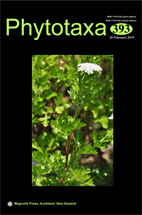Abstract
A new species of Magnolia from Sierra de Juárez, Oaxaca, Mexico, is described and illustrated. Magnolia yajlachhi belongs to sect. Talauma, subsect. Talauma, locally known as “yajlachhi” (flower of the heart, in Zapotec). It shares with M. lacandonica the subglobose mature fruit and the entirely white petals, but differs from the latter in having fewer carpels and stamens; more lateral leaf veins per side; and seeds orange vs. scarlet-red. It shares with M. zoquepopolucae the subglobose fruit but differs from the latter in having fewer carpels and stamens; petals entirely white vs. purplish in the upper portion (¾); more lateral leaf-veins per side; and seeds orange vs. scarlet-red. It shares with M. mexicana a similar number of carpels and stamens but it differs from the latter in having subglobose fruits to widely ovoid-depressed vs. widely ellipsoid; more leaf-veins per side; petals entirely white vs. adaxially purplish in the upper portion (¾); and seeds orange vs. scarlet-red. A key to Mexican species of sect. Talauma subsect. Talauma is provided. This species was assessed as Critically Endangered (CR). The species has a ceremonial and medicinal, conservation and nurse tree relevance in the Zapotecan culture.

